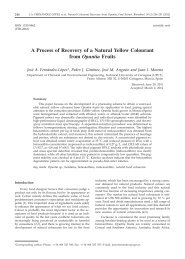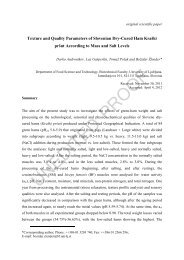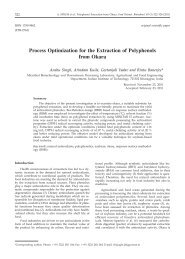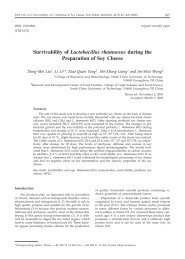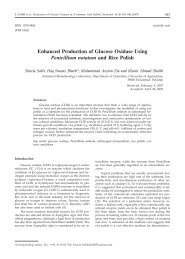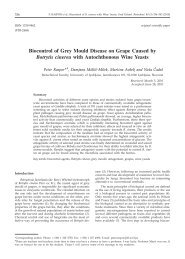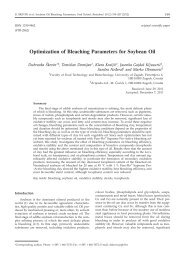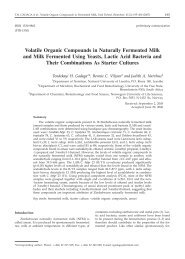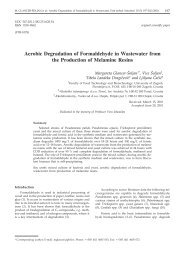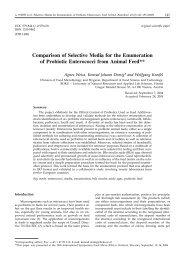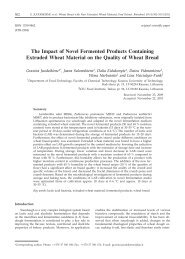Solid-State Fermentation of Silybum marianum L. Seeds Used as ...
Solid-State Fermentation of Silybum marianum L. Seeds Used as ...
Solid-State Fermentation of Silybum marianum L. Seeds Used as ...
Create successful ePaper yourself
Turn your PDF publications into a flip-book with our unique Google optimized e-Paper software.
FTB-3332<br />
original scientific paper<br />
<strong>Solid</strong>-<strong>State</strong> <strong>Fermentation</strong> <strong>of</strong> <strong>Silybum</strong> <strong>marianum</strong> L. <strong>Seeds</strong> <strong>Used</strong> <strong>as</strong> Additive to<br />
Incre<strong>as</strong>e the Nutritional Value <strong>of</strong> Wheat Bread<br />
Grazina Juodeikiene 1*∗ , Dalia Cizeikiene 1 , Vaida Ceskeviciute 1 , Daiva Vidmantiene 1 , Loreta<br />
B<strong>as</strong>inskiene 1 , Ieva Akuneca 2 , Mant<strong>as</strong> Stankevicius 2 , Audrius Maruska 2 , Elena Bartkiene 3 , Ona<br />
Ragazinskiene 4 and Algimant<strong>as</strong> Petrausk<strong>as</strong> 5<br />
1 Department <strong>of</strong> Food Technology, Faculty <strong>of</strong> Chemical Technology, Kaun<strong>as</strong> University <strong>of</strong> Technology,<br />
Radvilenu Rd. 19, LT-50254 Kaun<strong>as</strong>, Lithuania<br />
2 Department <strong>of</strong> Biochemistry and Biotechnologies, Vytaut<strong>as</strong> Magnus University, Vileikos st. 8,<br />
LT-44404 Kaun<strong>as</strong>, Lithuania<br />
3 Department <strong>of</strong> Food Safety and Animal Hygiene, Lithuanian University <strong>of</strong> Health Sciences, Tilzes st. 18,<br />
LT-47181 Kaun<strong>as</strong>, Lithuania<br />
4 Kaun<strong>as</strong> Botanical Garden, Vytaut<strong>as</strong> Magnus University, Z. E. Zilibero st. 6,<br />
LT-46324 Kaun<strong>as</strong>, Lithuania<br />
5 Pr<strong>of</strong>. Kazimier<strong>as</strong> Barsausk<strong>as</strong> Ultr<strong>as</strong>ound Research Institute, Studentu st. 50,<br />
LT-51368 Kaun<strong>as</strong>, Lithuania<br />
Received: February 9, 2013<br />
Accepted: March 29, 2013<br />
Summary<br />
In the present study <strong>Silybum</strong> <strong>marianum</strong> L. seeds were fermented using solid state fermentation<br />
(SSF) with several lactic acid bacteria (LAB) <strong>of</strong> Lactobacillus and Pediococcus genera, isolated<br />
from spontaneous Lithuanian rye sourdoughs. A possibility to improve sensory properties<br />
(flavour) <strong>of</strong> <strong>Silybum</strong> <strong>marianum</strong> L. seeds using LAB fermentation w<strong>as</strong> investigated. The<br />
composition <strong>of</strong> volatile compounds <strong>of</strong> the non-fermented and LAB fermented seeds <strong>of</strong> this plant<br />
w<strong>as</strong> analyzed using GC-MS. Fermented seeds have shown considerable differences mainly due<br />
to accumulation <strong>of</strong> higher alcohols. Total amount <strong>of</strong> phenolic compounds, flavonoids and 2,2-<br />
diphenylpicrylhydrazyl (DPPH) radical scavenging activity <strong>of</strong> non-fermented and fermented<br />
∗ Corresponding author; Phone: +370 37 300 188; Fax: +370 37 300 152; E-mail:<br />
grazina.juodeikiene@ktu.lt
seeds were determined spectrophotometrically. The results obtained indicate, that seeds <strong>of</strong><br />
<strong>Silybum</strong> <strong>marianum</strong> L, is a valuable source <strong>of</strong> bioactive compounds. The highest content <strong>of</strong><br />
phenolic compounds and flavonoids (4596 and 1346 mg <strong>of</strong> rutin equivalents (RE)/100g,<br />
respectively) w<strong>as</strong> determined for P. acidilactici KTU05-7 bacteria by solid state fermented<br />
seeds. <strong>Silybum</strong> <strong>marianum</strong> L. seeds fermented with P. acidilactici KTU05-7 and Pedioccus<br />
pentosaceus KTU05-9 showed stronger antioxidant activity (1263 and 1041 mg RE/100g<br />
respectively) comparing to un-fermented seeds (805 mg RE/100g). The addition <strong>of</strong> the P.<br />
acidilactici KTU05-7 bacteria fermented <strong>Silybum</strong> <strong>marianum</strong> L. seeds had the highest effect on<br />
the decre<strong>as</strong>e <strong>of</strong> the bacterial spoilage <strong>of</strong> bread. The aroma compounds, extracted from this<br />
fermented seeds with supercritical carbon dioxide, demonstrated the highest antimicrobial<br />
activity against the tested microorganisms. Ultr<strong>as</strong>onic pre-treatment <strong>of</strong> the seeds reduced the<br />
total amount <strong>of</strong> microorganisms in the raw material. Microbiological tests revealed, that the<br />
highest antimicrobial effect is achieved using the solid-state fermentation conditions. This study<br />
revealed that fermented <strong>Silybum</strong> <strong>marianum</strong> L. seeds are a suitable additive for natural flavouring<br />
<strong>of</strong> baked goods.<br />
Key words: solid state fermentation, lactic acid bacteria, <strong>Silybum</strong> <strong>marianum</strong> L., ultr<strong>as</strong>ound,<br />
phenolic compounds, flavonoids, flavour compounds, antioxidant activity<br />
Introduction<br />
<strong>Solid</strong>-state fermentation (SSF), which consists <strong>of</strong> the microbial growth and product formation on<br />
solid particles in the absence (or near absence) <strong>of</strong> water, h<strong>as</strong> recently attracted special attention<br />
<strong>of</strong> researchers and manufacturers since it is more economical, compared with the traditional way<br />
<strong>of</strong> microorganisms cultivation in a nutrients containing liquid medium (1–4).<br />
Several important factors have to be considered for the development <strong>of</strong> a successful bioprocess<br />
under SSF conditions. Some <strong>of</strong> the most important include selection <strong>of</strong> (I) suitable<br />
microorganism strain and (II) solid substrate to be used. A variety <strong>of</strong> microorganisms, including<br />
molds, ye<strong>as</strong>ts and bacteria may be used for SSF processes. Molds and ye<strong>as</strong>ts are the most<br />
common microorganisms used in the low water content fermentation systems, due to their ability<br />
to grow in such environments. Filamentous fungi have great potential to produce bioactive
compounds by SSF, therefore, they are the most common microorganisms used for this purpose<br />
(2,5,6). Filamentous fungi have also received great attention due to their ability to produce<br />
thermostable enzymes <strong>of</strong> high scientific and commercial value, such <strong>as</strong> amyl<strong>as</strong>es, pectin<strong>as</strong>es,<br />
xylan<strong>as</strong>es, cellul<strong>as</strong>es, chitin<strong>as</strong>es, prote<strong>as</strong>es, lip<strong>as</strong>es, β-galactosid<strong>as</strong>es etc. (7,8). However, the<br />
choice <strong>of</strong> the microorganism to be used in SSF depends on the desired end products. John et al.<br />
(9) demonstrated that lactic acid bacteria (LAB) like L. delbrüeckii, which are known for L-lactic<br />
acid production, can be used for SSF. In food fermentation processes e.g. sourdough ecosystems,<br />
LAB (10) and ye<strong>as</strong>t account for the dominant micr<strong>of</strong>lora and contribute not only to the<br />
development <strong>of</strong> the desired sensory properties <strong>of</strong> the final products but also to its microbiological<br />
safety, either <strong>as</strong> the natural micr<strong>of</strong>lora or <strong>as</strong> starter cultures added under controlled conditions.<br />
The structural genes <strong>of</strong> LAB are responsible for the antimicrobial activity <strong>of</strong> the strains. Until<br />
now, the main focus h<strong>as</strong> been given to LAB-producing natural antimicrobials such <strong>as</strong> organic<br />
acids, hydrogen peroxide, CO 2 , diacetyl, acetaldehyde, D-isomers <strong>of</strong> amino acids and reuterin.<br />
Over the l<strong>as</strong>t few years there h<strong>as</strong> been an explosion <strong>of</strong> research on ribosomal synthesized and<br />
extracellular rele<strong>as</strong>ed proteinaceous compounds, i.e. bacteriocins produced by LAB, which<br />
exhibit bactericidal and/or bacteriostatic modes <strong>of</strong> action against closely related species and even<br />
food-borne pathogens.<br />
The main attention so far w<strong>as</strong> paid to apply residues, including c<strong>of</strong>fee pulp and husk, sugarcaneand<br />
agave-bag<strong>as</strong>se, fruit pulps and peels, corn cobs, among others, <strong>as</strong> supports and/or substrates<br />
for the production <strong>of</strong> enzymes by SSF (11–14), organic acids (9,15,16), antibiotics (17,18),<br />
flavor and aroma compounds (19–21) and bioactive compounds (22,23).<br />
The SSF process variables including pre-treatment and particle-size <strong>of</strong> substrates, medium<br />
ingredients, supplementation <strong>of</strong> growth medium, sterilization <strong>of</strong> SSF medium, moisture content,<br />
water activity (a w ), inoculum density, temperature, pH, agitation and aeration have a significant<br />
effect on the efficiency <strong>of</strong> SSF processes (24). Among these, the moisture content and a w have an<br />
important role in SSF, and have been studied, described, and revised by several authors.<br />
Generally, the substrates have a water content ranging between 30 and 85%. Lower values may<br />
induce the sporulation <strong>of</strong> the microorganism, while more elevated levels may reduce the porosity<br />
<strong>of</strong> the system, which can result in oxygen transfer limitations, which incre<strong>as</strong>e the risk <strong>of</strong> bacterial<br />
contamination (25).
Recently, considerable interest h<strong>as</strong> arisen in the application <strong>of</strong> pulsed ultr<strong>as</strong>ound technology <strong>as</strong><br />
one <strong>of</strong> the few alternative technological means for the elimination <strong>of</strong> the bacterial contamination<br />
<strong>of</strong> fermentation media. High intensity pulses <strong>of</strong> sound waves have been shown to cause the<br />
cavitations and collapse <strong>of</strong> micro bubbles that can be used to destroy several bacteria and<br />
degrade other pollutants (26). However, there is a lack <strong>of</strong> published data on the antimicrobial<br />
effect <strong>of</strong> pulsed ultr<strong>as</strong>ound treatment on plant products and lactic acid bacteria cultivation<br />
processes in SSF.<br />
Furthermore, according to the literature, the use <strong>of</strong> SSF can incre<strong>as</strong>e the production <strong>of</strong> bioactive<br />
phenolic compounds (27,28,29,30).<br />
The object <strong>of</strong> this study is therefore to select optimal conditions <strong>of</strong> solid-state fermentation for<br />
the incre<strong>as</strong>e <strong>of</strong> the nutrition value in plant products using bacteriocin like inhibitory substances<br />
(BLIS) producing lactic acid bacteria (LAB).<br />
Material and Methods<br />
Microorganisms and culture conditions<br />
Lactobacillus sakei KTU05-6, Pediococcus acidilactici KTU05-7, P. pentosaceus KTU05-8,<br />
KTU05-9 and KTU05-10 previously isolated from spontaneous Lithuanian rye sourdoughs and<br />
selected due to their preliminary inhibiting properties (31) were obtained from the culture<br />
collection <strong>of</strong> Kaun<strong>as</strong> University <strong>of</strong> Technology, Department <strong>of</strong> Food Science and Technology.<br />
Strains were stored at -70 o C in a Microbank system (PRO-LAB DIAGNOSTICS) and were later<br />
propagated in a Man Rogosa Sharpe (MRS) medium (Oxoid, Milan, Italy) at their optimal<br />
temperatures 25 o C (KTU05-8 and KTU05-9), 30 o C (KTU05-6) or 35 o C (KTU05-10 and<br />
KTU05-7) for 24 hours.<br />
Plant material<br />
As a model system the seeds <strong>of</strong> the milk thistle (<strong>Silybum</strong> <strong>marianum</strong> L. Gaertn.) were selected and<br />
analyzed. Plant w<strong>as</strong> grown and seeds collected <strong>of</strong> an experimental field located in the Kaun<strong>as</strong><br />
Botanical Garden <strong>of</strong> Vytaut<strong>as</strong> Magnus University (KBG VMU) in 2011. The seeds were dried to<br />
a water content <strong>of</strong> approximately 7 % and stored in dark at ambient temperatures.
Preparation <strong>of</strong> fermented products<br />
SSF h<strong>as</strong> been carried out at the Department <strong>of</strong> Food Technology <strong>of</strong> Kaun<strong>as</strong> University <strong>of</strong><br />
Technology (KTU). In the first step the seeds were ground in a laboratory-scale impact mill<br />
MIAG (Germany) to a particle size fraction <strong>of</strong> 0,5-2 mm. 2 % (<strong>of</strong> total water and seeds m<strong>as</strong>s) <strong>of</strong><br />
freshly prepared LAB w<strong>as</strong> mixed with sterile water and sprayed on freshly milled seeds, mixed<br />
and fermented at the optimal temperatures <strong>of</strong> LAB‘s <strong>as</strong> previous mentioned for 72 h. As control<br />
for sensory properties evaluation Sacharomyces cerevisiae ye<strong>as</strong>t w<strong>as</strong> used <strong>as</strong> starter material<br />
instead <strong>of</strong> the LAB in the fermentation process (at 30 o C for 72 h). Fermented product properties<br />
such <strong>as</strong>: the total titration acidity (TTA), pH, the LAB growth and total number <strong>of</strong><br />
microorganisms were determined during 24, 48 and 72 h <strong>of</strong> fermentation. The total phenolicsand<br />
flavonoids-content, composition <strong>of</strong> phenolic compounds and the quantitative and qualitative<br />
composition <strong>of</strong> volatile compounds <strong>as</strong> well <strong>as</strong> total radical scavenging activity were determined<br />
for <strong>Silybum</strong> <strong>marianum</strong> seeds before and after 72 h <strong>of</strong> solid state fermentation.<br />
For selection <strong>of</strong> the optimal SSF conditions the obtained seeds m<strong>as</strong>s (before LAB fermentation)<br />
have been pre-treated by low frequency ultr<strong>as</strong>ound (20 kHz). The treatment time for the different<br />
samples varied from 0 till 480 s in steps <strong>of</strong> ca. 100 s. Fermented products were prepared by<br />
inoculating 2 % <strong>of</strong> the freshly prepared LAB starter to the seed m<strong>as</strong>s. The fermentation processes<br />
h<strong>as</strong> been carried out for 72 h at an optimal temperature for certain LAB. In this stage, the<br />
fermented products have been used for the analysis <strong>of</strong> LAB content, total content <strong>of</strong><br />
microorganisms and fungi determination. As controls the traditional and intermediate ways <strong>of</strong><br />
fermentation have been carried out (moisture content <strong>of</strong> fermented seeds w<strong>as</strong> 70 % and 60 %,<br />
respectively).<br />
Ultr<strong>as</strong>ound treatment<br />
The plant seeds were exposed to ultr<strong>as</strong>onic vibrations in the frequency range <strong>of</strong> 20-25 kHz to<br />
cause resonant vibrations in the seeds. The ultr<strong>as</strong>onic frequency around 20 kHz w<strong>as</strong> chosen<br />
because in the range around this frequency about ¼ <strong>of</strong> the wavelength <strong>of</strong> flexural vibration is<br />
present along the seed’s axis. In such a way, syneresis occurs and resonant vibrations are excited<br />
in the seeds. By sweeping the ultr<strong>as</strong>onic frequency in a small range, the vibrations <strong>of</strong> the whole<br />
seed m<strong>as</strong>s are improved because in reality each grain is slightly different from another. The<br />
intensity <strong>of</strong> the ultr<strong>as</strong>ound w<strong>as</strong> around 120 dB which corresponds to acoustic pressure <strong>of</strong> around
20 Pa. To achieve this kind <strong>of</strong> acoustic pressure, an ultr<strong>as</strong>onic cleaning vessel SS-802F Pro*sKit<br />
w<strong>as</strong> used.<br />
Wheat bread making with fermented <strong>Silybum</strong> <strong>marianum</strong> seeds<br />
The LAB strain P. acidilactici KTU05-7 which showed the positive effect on sensory properties<br />
and incre<strong>as</strong>ed nutrition value <strong>of</strong> fermented products were further tested to determinate their antimicrobial<br />
activities during bread storage. Wheat bread samples were prepared using P.<br />
acidilactici KTU05-7 <strong>as</strong> starter for fermented product preparation according to Juodeikiene et al.<br />
(32).<br />
A simple formulation <strong>of</strong> wheat bread w<strong>as</strong> used to reduce additional effects <strong>of</strong> other ingredients<br />
consisting <strong>of</strong> wheat flour (100 g), compressed ye<strong>as</strong>t (2 g), salt (1.5 g) and water (required to<br />
reach 46 % dough moisture content). Baking tests were carried out by adding 2 % fermented and<br />
1 % dried <strong>Silybum</strong> <strong>marianum</strong> seeds to the bread formulations. The control baking test without<br />
additives w<strong>as</strong> carried out at the same time. After baking the bread samples were stored for 5 days<br />
(120 h) at room temperature. The quality evaluation <strong>of</strong> breads w<strong>as</strong> performed 24 h after baking.<br />
Antimicrobial analysis <strong>of</strong> bread w<strong>as</strong> determined in bread crust and crumb after 2 h after baking<br />
and after 5 days <strong>of</strong> storage.<br />
Preparation <strong>of</strong> extracts<br />
For spectrophotometric and high performance liquid chromatography (HPLC) analyses extracts<br />
<strong>of</strong> 0.1 g (dry) or 0.5 g not dried, frozen or fermented samples (the precise weight <strong>of</strong> dry material<br />
w<strong>as</strong> determined for each sample) in 4 mL <strong>of</strong> aqueous methanol (1:3, (v/v),) were prepared using<br />
a TiterTek shaker (Germany) for 15 h. Extracts were filtered through a paper filter and 0.22 µm<br />
disposable Durapore PVDF membrane-filter (Millipore, USA) before analysis. The extracts were<br />
stored at +4 °C for further analyses.<br />
Chemicals<br />
HPLC grade methanol, acetic acid (99 %), sodium hydroxide and aluminium chloride were from<br />
Lachema (Czech Republic). Folin & Ciocalteu’s phenol reagent, 2,2-diphenyl-1-picrylhydrazyl<br />
(DPPH), HPLC grade acetonitrile and rutin were from Sigma-Aldrich (Germany). Anhydrous
Sodium carbonate w<strong>as</strong> from Eurochemicals (Slovakia). Hexamethylentetramine (98 %) w<strong>as</strong> from<br />
Fluka (Switzerland). Sodium acetate w<strong>as</strong> from Fisher Scientific Company (USA).<br />
Determiantion <strong>of</strong> total amount <strong>of</strong> phenolic compounds<br />
Total amount <strong>of</strong> phenolic compounds (TPC) w<strong>as</strong> determined using a slightly modified Folin-<br />
Ciocalteu method (33). 100 µL <strong>of</strong> sample extract w<strong>as</strong> mixed with 3000 µL <strong>of</strong> sodium carbonate<br />
solution (3.3 %) and 100 µL <strong>of</strong> Folin – Ciocalteu reagent (2 N). After 30 min. <strong>of</strong> incubation at<br />
room temperature, the absorbance w<strong>as</strong> me<strong>as</strong>ured at 760 nm using a spectrophotometer<br />
Spectronic 1201 (Milton Roy, USA). For calibration <strong>as</strong> standard compound rutin (0.01–1.00<br />
mg/mL) w<strong>as</strong> used. The TPC w<strong>as</strong> expressed in rutin equivalents (RE), mg/100 g <strong>of</strong> dry matter.<br />
Determination <strong>of</strong> total amount <strong>of</strong> flavonoids<br />
The total amount <strong>of</strong> flavonoid compounds (TFC) w<strong>as</strong> evaluated according to a modified<br />
spectrophotometric <strong>as</strong>say using an aluminium chloride method (34). Stock solution consisted <strong>of</strong><br />
60 mL <strong>of</strong> pure methanol, 3 mL <strong>of</strong> acetic acid (33 %), 12 mL <strong>of</strong> hexametylentetramine (5 %), 9<br />
mL <strong>of</strong> aluminium chloride (10 %) and 60 mL <strong>of</strong> bi-distilled water w<strong>as</strong> prepared before analysis.<br />
80 µL <strong>of</strong> sample extract w<strong>as</strong> added to 1920 µL <strong>of</strong> stock solution and mixed. After 30 min. <strong>of</strong><br />
incubation in the refrigerator (+4 °C) the absorbance at 407 nm w<strong>as</strong> me<strong>as</strong>ured. The calibration<br />
curve w<strong>as</strong> prepared using rutin <strong>as</strong> a standard compound (0.01–1.00 mg/mL). TFC w<strong>as</strong> expressed<br />
in rutin equivalents (RE), mg per 100 g <strong>of</strong> dry matter.<br />
Determination <strong>of</strong> antioxidant activity<br />
Antioxidant activity w<strong>as</strong> determined using 2,2-diphenylpicrylhydrazyl (DPPH) radical<br />
scavenging capacity <strong>as</strong>say (35). The 100 mM sodium acetate buffer solution (pH 5.5) and DPPH<br />
radical solution (0.1 mM in ACN and methanol, 1:1 v/v) were prepared before analysis. The<br />
equal volumes (250 mL) <strong>of</strong> buffer and radical solution were mixed and the absorbance w<strong>as</strong><br />
adjusted adding acetate buffer to 0.500 AU. Sample extract (77 µL) w<strong>as</strong> mixed with 3000 µL <strong>of</strong><br />
DPPH solution. After 15 min. <strong>of</strong> incubation at room temperature in the dark, the absorbance w<strong>as</strong><br />
me<strong>as</strong>ured at 515 nm. Control sample w<strong>as</strong> prepared mixing reagents and solvent without test<br />
compounds. To obtain the calibration curve rutin solutions (0.05 – 0.25 mg/mL) were used.<br />
Antioxidant activity w<strong>as</strong> expressed in rutin equivalents (RE), mg per 100 g <strong>of</strong> dry material.
Analysis <strong>of</strong> volatile compounds using GC-MS<br />
Samples for g<strong>as</strong> chromatographic analysis were prepared using solid ph<strong>as</strong>e micro-extraction<br />
(SPME). For samples preparation SPME device with Stableflex (TM) fiber coated with 65 µm<br />
PDMS-DVB layer (Supelco, USA) w<strong>as</strong> used. For extraction 0.01 g <strong>of</strong> sample material w<strong>as</strong><br />
placed in the 10 mL gl<strong>as</strong>s vial with the PTFE lined silicone septa. The fiber w<strong>as</strong> exhibited in the<br />
headspace <strong>of</strong> the sample at 25 o C for 1 h. The injection w<strong>as</strong> performed by thermal desorption <strong>of</strong><br />
the volatiles in the injection port <strong>of</strong> the g<strong>as</strong> chromatograph at 230 °C. For g<strong>as</strong> chromatography -<br />
m<strong>as</strong>s spectrometry a model GCMS-QP2010 g<strong>as</strong> chromatograph with a m<strong>as</strong>s spectrometric<br />
detector (Shimadzu, Japan) w<strong>as</strong> used. The ionization <strong>of</strong> the analytes w<strong>as</strong> perforemed using an<br />
electron ionization mode at 70 eV. For separation <strong>of</strong> volatiles a low polarity RTX-5MS column<br />
(Restek, USA) (length 30 m, coating thickness 0.25 µm, the inner diameter <strong>of</strong> 0.25 mm) w<strong>as</strong><br />
used. Ion source temperature w<strong>as</strong> set at 220 °C, interface temperature w<strong>as</strong> 260 °C. Sample<br />
injection w<strong>as</strong> carried out for 1 min. in order to ensure full desorption <strong>of</strong> volatiles from the SPME<br />
fiber. Split mode injection (1:10) w<strong>as</strong> used. Temperature gradient program w<strong>as</strong> set <strong>as</strong> follows:<br />
from 30 °C till 200 °C at 5 °C/min. and up to 280 °C at 20 °C/min. and maintained for 2 minutes.<br />
The carrier g<strong>as</strong> 99.999 % helium (AGA, Lithuania) by a pressure <strong>of</strong> 90 kPa at the column head,<br />
at the column flow <strong>of</strong> 1.61 mL/min. w<strong>as</strong> used. The compounds were identified according to the<br />
m<strong>as</strong>s spectra library NIST 8.0s (USA). For solid ph<strong>as</strong>e micro extraction – g<strong>as</strong> chromatography<br />
m<strong>as</strong>s spectrometry method w<strong>as</strong> repeated me<strong>as</strong>ured by extracting and injecting 5 identic samples.<br />
The relative standard deviation (RSD) for peak area did not exceed 5.15 %.<br />
Fermented product and bread quality evaluation<br />
Total titratable acidity (TTA) and pH <strong>of</strong> the fermented products and bread crumbs were<br />
me<strong>as</strong>ured according to the method described in AACC (36). The TTA value w<strong>as</strong> expressed in<br />
milliliters <strong>of</strong> 0.1 M NaOH solution used per 10 g <strong>of</strong> sample to obtain pH 8.5. The specific<br />
volume <strong>of</strong> the bread samples w<strong>as</strong> evaluated <strong>as</strong> described in AACC (36). Sensory evaluations <strong>of</strong><br />
the fermented products and breads were conducted by 15 panellists, consisting <strong>of</strong> KTU staff and<br />
students, using a 7-point rating scale for the odour <strong>of</strong> the fermented products and 8 bread<br />
attributes (bread odour, spice odour, bread flavour, spice flavour, acidity, bread firmness,<br />
springiness and moistness). Number 1 corresponded to the lowest intensity and number 7 to the<br />
highest intensity <strong>of</strong> the attribute. The fermented products and breads also were evaluated for
overall acceptability using a 7-point hedonic scale where 7 is “like extremely” and 1 “dislike<br />
extremely”. Coded samples were served and water w<strong>as</strong> provided for rinsing between the sensory<br />
procedures <strong>of</strong> the samples.<br />
<strong>Seeds</strong>, fermented products and bread microbiological analysis<br />
The effect <strong>of</strong> a novel fermentation medium on the growth <strong>of</strong> LAB w<strong>as</strong> tested by determining<br />
their number in the newly prepared fermented products on the first, second and third day <strong>of</strong><br />
fermentation. LAB counts in fermented product samples were determined on MRS agar<br />
(Li<strong>of</strong>ilchem, Roseto degli Abruzzi, Teramo, Italy) using plate count techniques. Plates were<br />
incubated for (72±4) h under anaerobic conditions (AnaeroGen, Oxoid). The experiment w<strong>as</strong><br />
carried out in triplicate.<br />
Primary seeds and fermented products microbiological contamination w<strong>as</strong> evaluated by<br />
calculating the total number <strong>of</strong> microorganism and were expressed by colony forming units per<br />
gram <strong>of</strong> product (CFU/g) using Plate Count Agar media (Li<strong>of</strong>ilchem, Italy) according to LST EN<br />
ISO 4833:2003 (37).<br />
The effect <strong>of</strong> fermented products on the microbiological characteristics <strong>of</strong> wheat bread w<strong>as</strong><br />
determined by determining the total number <strong>of</strong> microorganisms, spores <strong>of</strong> fungi and the number<br />
<strong>of</strong> the spores producing aerobic mesophilic bacteria in bread crust and crumb 2 h after baking<br />
and after 5 days storage at ambient temperatures (18–25 o C) and expressed by colony forming<br />
units per gram <strong>of</strong> product (CFU/g).<br />
The fungi were determined in ye<strong>as</strong>t extract, glucose and chloramphenicol agar (Li<strong>of</strong>ilchem, REF<br />
610070) after incubation for 5 days at 25 o C. The number <strong>of</strong> spores producing aerobic mesophilic<br />
bacteria were determined in Plate Count Agar (Li<strong>of</strong>ilchem, REF 610040) (before inoculation into<br />
plates the dilutions were heated for 10 min. at 80 o C) after incubation for 3 days at 30 o C.<br />
Supercritical carbon dioxide extraction and antimicrobial activity evaluation<br />
Essential oils were extracted from <strong>Silybum</strong> <strong>marianum</strong> L seeds using the supercritical carbon<br />
dioxide (99.9 % purity, AGA, Lithuania) extraction. For supercritical fluid extraction a HP<br />
7680T (Hewlett Packard, USA) apparatus w<strong>as</strong> used. Extraction conditions: CO 2 density 0.3<br />
g/mL; pressure 88 bar, temperature <strong>of</strong> the trap 5 °C and the extraction time 15 min.; volume <strong>of</strong><br />
the extract fractions w<strong>as</strong> 1.4 mL, CO 2 flow rate at the dynamic extraction w<strong>as</strong> 1 mL/min.;
solvent – methanol; 0.5 g <strong>of</strong> sample for extraction w<strong>as</strong> used. The trap w<strong>as</strong> filled with<br />
ocatadecylsilane (ODS) modified silica solid ph<strong>as</strong>e extraction particles. After trapping, the<br />
essential oils were desorbed flushing solid ph<strong>as</strong>e adsorbent with methanol. The desorbed<br />
fractions were collected and kept in the refrigerator at 4 °C until GC–MS and antimicrobial<br />
analysis. Extracts antimicrobial activities were tested against Bacillus subtilis subsp. subtilis,<br />
Esherichia coli, Salmonella typhimurium, Pseudomon<strong>as</strong> gladioli pv. aliicola, P. cepacia, P.<br />
fluorescens, P. marginalis, P. facilis, P. aure<strong>of</strong>aciens biovar. III, P. cichorii, A. niger, F.<br />
culmorum indicator microorganisms, isolated from varies food, according to the method<br />
described by Cizeikiene et al (31).<br />
Statistical analysis<br />
All experimental me<strong>as</strong>urements were carried out in triplicate and are expressed <strong>as</strong> mean values ±<br />
standard deviation. The significance <strong>of</strong> each instrumental me<strong>as</strong>urement/descriptive attribute in<br />
discriminating between the samples w<strong>as</strong> analyzed.<br />
Results and Discussion<br />
Quality and antimicrobial activity <strong>of</strong> fermented <strong>Silybum</strong> <strong>marianum</strong> (seeds) products<br />
The sensory properties <strong>of</strong> fermented products, characterized <strong>as</strong> intensity and acceptability <strong>of</strong><br />
flavour, are important quality criteria. The seeds <strong>of</strong> <strong>Silybum</strong> <strong>marianum</strong> L, are a valuable source<br />
<strong>of</strong> bioactive substances. Lactic acid bacteria (LAB) are used for industrial food fermentation<br />
since they contribute to the preservation <strong>of</strong> the foods <strong>as</strong> well <strong>as</strong> to their texture and flavour (38–<br />
40). In this study the possibilities to improve the sensory properties (flavour) <strong>of</strong> <strong>Silybum</strong><br />
<strong>marianum</strong> seeds using LAB fermentation have been studied (Fig. 1).<br />
The results <strong>of</strong> sensory evaluation <strong>of</strong> fermented products showed that the seeds <strong>of</strong> <strong>Silybum</strong><br />
<strong>marianum</strong> L. provide the specific odour after fermentation, which is ple<strong>as</strong>ing and acceptable for<br />
consumers. It h<strong>as</strong> been noticed, that after fermentation the quality <strong>as</strong> well <strong>as</strong> the intensity <strong>of</strong><br />
odour have been essentially changed. In all c<strong>as</strong>es the odour <strong>of</strong> fermented products w<strong>as</strong><br />
acceptable for consumers. However some differences in odour <strong>of</strong> fermented products using<br />
different LAB strains have been noticed. The sweet and delicate odour h<strong>as</strong> been achieved using<br />
one <strong>of</strong> the strains from the Department <strong>of</strong> Food Technology KTU collection - L. sakei KTU05-6
for the seed fermentation, however the intensity <strong>of</strong> the odour w<strong>as</strong> low. Using other LAB strains<br />
for seed fermentation, malty odour characteristics have been noticed. This study revealed that<br />
fermented <strong>Silybum</strong> <strong>marianum</strong> L. seeds could be a suitable additive for natural flavouring <strong>of</strong><br />
baked goods. Interestingly, ye<strong>as</strong>t Saccharomyces cerevisiae used in traditional bread<br />
fermentation processes also gave an intensive and acceptable odour for the fermented plant<br />
products, typical for the cereal drink „Kv<strong>as</strong>“, which is traditional in E<strong>as</strong>tern Europe.<br />
The results <strong>of</strong> total titratable acidity showed that TTA values <strong>of</strong> fermented products during 72 h<br />
fermentation incre<strong>as</strong>ed and obtained the highest TTA values 12.5; 13.3 and 14.8, respectively<br />
fermented with P. acidilactici, L. sakei and P. pentosaceus KTU05-10. pH values during<br />
fermentation decre<strong>as</strong>ed and ranged from 4.7 – 5.0 after 72 h. (Fig. 2a). Highest LAB number w<strong>as</strong><br />
observed on 48-72 h <strong>of</strong> fermentation (Fig. 2b). The acidification activity <strong>of</strong> LAB indicates most<br />
<strong>of</strong> the beneficial properties attributed to the fermented products. The main factor regulating<br />
acidification is the amount <strong>of</strong> fermentable carbohydrates (41,42), although the production <strong>of</strong><br />
acids depends also on other parameters such <strong>as</strong> fermentation temperature and time (43).<br />
Antimicrobial activity <strong>of</strong> extracts <strong>of</strong> <strong>Silybum</strong> <strong>marianum</strong> L seeds and fermented seed products is<br />
shown in Table 1. Essential oils extracts from <strong>Silybum</strong> <strong>marianum</strong> L seeds show quite low<br />
antimicrobial activity only against B. subtilis, where<strong>as</strong> extracts prepared from fermented seeds<br />
with Pediococcus acidilactici KTU05-7 show inhibition radius till 3 mm against E coli and P.<br />
gladioli and lower inhibition against B. subtilis, P. cepacia and P. aure<strong>of</strong>aciens. Moreover<br />
extracts from seeds fermented with P. pentosaceus KTU05-10 show inhibition radius till 5 mm<br />
against P. gladioli and P. fluorescens 3.3 and somewhat lower inhibition against B. subtilis, E.<br />
coli, S. typhimurium, P. cepacia and P. facilis.<br />
Optimisation <strong>of</strong> plant SSF process conditions<br />
The microbiological analysis <strong>of</strong> fermented product samples under laboratory conditions revealed<br />
that the total microorganisms counts (TMC) range from 74.5×10 7 to 89.5×10 7 CFU/g (Fig. 3).<br />
The TMC counts determined were lower ca. 8.6 and 16.8 % in SSF substrates than in traditional<br />
and intermediate fermentation media, respectively. The numbers <strong>of</strong> fungi counts detected in SSF<br />
substrate were lower approximately by 40.6 and 16.7 % than in traditional and intermediate<br />
fermentation media, respectively.
The tendency <strong>of</strong> the reduction in the TMC populations in fermented products w<strong>as</strong> observed with<br />
the extension <strong>of</strong> the ultr<strong>as</strong>ound treatment time <strong>of</strong> the seed raw material (Fig. 4a). The LAB<br />
numbers in different model systems <strong>of</strong> <strong>Silybum</strong> <strong>marianum</strong> seeds representing SSF, intermediate<br />
and traditional fermentation are given in Figure 4b.<br />
The ultr<strong>as</strong>ound treatment w<strong>as</strong> effective on SSF, intermediate and traditional way <strong>of</strong> fermentation.<br />
The reduction <strong>of</strong> CFU in SSF media within 90; 180; 280 and 380 s ultr<strong>as</strong>ound treatment w<strong>as</strong><br />
found by ca. 6.4, 40.5, 68.8 and 84.9 %, respectively, while using traditional way <strong>of</strong> fermentation<br />
this parameter decre<strong>as</strong>ed by 24.0, 46.0, 68.8 and 80.0 %, respectively. Longer ultr<strong>as</strong>ound<br />
treatment time (480 s) did not show significant influence on the reduction <strong>of</strong> microbiological<br />
contamination in the fermented products.<br />
This phenomenon can be explained by the impact <strong>of</strong> sound waves on extraneous micr<strong>of</strong>lora <strong>as</strong><br />
well <strong>as</strong> the incre<strong>as</strong>ed amount <strong>of</strong> antimicrobial compounds rele<strong>as</strong>ed from plant cells destroyed by<br />
ultr<strong>as</strong>ound (44).<br />
Furthermore, the effect <strong>of</strong> moisture content <strong>of</strong> fermentation media on the changes in LAB count<br />
w<strong>as</strong> analysed (Fig. 4b). The microbiological analysis <strong>of</strong> the inoculated LAB samples revealed<br />
that the count <strong>of</strong> P. acidilactici varied from 2.56×10 8 to 2.86×10 8 CFU/g. Most <strong>of</strong> the samples<br />
contained LAB cells within the range reported by other authors (45-48). The highest level <strong>of</strong><br />
LAB (2.86×10 8 CFU/g) w<strong>as</strong> detected in fermented products with a moisture content <strong>of</strong> 50 %<br />
(corresponding SSF), while in the c<strong>as</strong>e <strong>of</strong> higher moisture levels (60 % and 70 %) the detected<br />
LAB levels were observed slightly lower 2.79×10 8 CFU/g and 2.56×10 8 CFU/g, respectively.<br />
There is some controversy around the effect <strong>of</strong> fermentation media moisture content on LAB<br />
growth. Wang et al. (49) reported that lactic acid bacteria survive better at low-water activity,<br />
while Hansen and Schieberle (50) stated that a medium with high water content w<strong>as</strong> more proper<br />
for the LAB cultivation due to the solubility <strong>of</strong> nutrients in the medium. Nevertheless,<br />
microorganisms are found to be very sensitive to the changes in water content and nutrient<br />
concentration. The direct addition <strong>of</strong> selected starter cultures to raw materials is a highlight in the<br />
production <strong>of</strong> fermented foods helping to control the overall standardization <strong>of</strong> the fermentation<br />
process and quality <strong>of</strong> the end product (51).
Influence <strong>of</strong> fermentation on nutrition value <strong>of</strong> <strong>Silybum</strong> <strong>marianum</strong> L. seeds product<br />
In our experiment different bacteriocins like inhibitory substances producing LAB strains for<br />
SSF <strong>of</strong> <strong>Silybum</strong> <strong>marianum</strong> L. seeds were used to study the effects <strong>of</strong> fermentation on the total<br />
amount <strong>of</strong> phenolic compounds and flavonoids pr<strong>of</strong>ile and antioxidant status. As Fig. 5<br />
demonstrates, the influence <strong>of</strong> SSF on the content <strong>of</strong> biological active compounds is dependent<br />
on the type <strong>of</strong> microorganisms (LAB or ye<strong>as</strong>t) and the used strain <strong>of</strong> LAB. The highest level <strong>of</strong><br />
phenolic compounds and flavonoids w<strong>as</strong> obtained using fermentation <strong>of</strong> seeds with P.<br />
acidilactici KTU05-7 (4596 and 1346 mg RE/100 g, respectively), while using ye<strong>as</strong>t the total<br />
content <strong>of</strong> these components decre<strong>as</strong>ed during fermentation from 3512 (in the raw material) to<br />
2638 and from 1167 to 851 mg RE/100 g. <strong>Silybum</strong> <strong>marianum</strong> L. seeds fermented using SSF with<br />
P. acidilactici KTU05-7 and Pedioccus pentosaceus KTU05-9) showed a stronger antioxidant<br />
activity (1263 and 1041 mg RE/100 g respectively), than unfermented products (805 mg RE/100<br />
g), which w<strong>as</strong> probably related to the markedly higher contents <strong>of</strong> phenolic acids, flavonoids and<br />
aglycone iso-flavone with more free hydroxyl groups formed during SSF (52). Another different<br />
LAB strain such <strong>as</strong> L. sakei KTU05-6 used in SSF w<strong>as</strong> not effective for the improvement <strong>of</strong> the<br />
bioactivity and antioxidant properties <strong>of</strong> <strong>Silybum</strong> <strong>marianum</strong> L. seeds.<br />
The results <strong>of</strong> GC-MS SPME analysis are presented in Table 2. The compositions <strong>of</strong> volatile<br />
compounds <strong>of</strong> the non-fermented <strong>Silybum</strong> <strong>marianum</strong> L. seeds (reference) and LAB fermented<br />
products <strong>of</strong> this plant have shown considerable differences. Both quantitative and qualitative<br />
differences have been observed. Fermented products mainly differed by accumulation <strong>of</strong> higher<br />
alcohols. It is evident that different compounds predominate in the reference sample and<br />
fermented samples. The main compounds found in the headspace <strong>of</strong> <strong>Silybum</strong> <strong>marianum</strong> L.<br />
fermented seeds were <strong>as</strong> follows: isopentyl alcohol 55.6 %, n-hexanol up to 23 % and butyl<br />
carbinol (amyl alcohol) which varied from 5 % to 13 %, unlike in seeds fermented with ye<strong>as</strong>t,<br />
where the amount <strong>of</strong> the latter compound incre<strong>as</strong>ed to 21 %. Interestingly, there w<strong>as</strong> no ethanol<br />
determined in the headspace <strong>of</strong> the ye<strong>as</strong>t fermented <strong>Silybum</strong> <strong>marianum</strong> L. seeds, which w<strong>as</strong> the<br />
c<strong>as</strong>e by fermenting some other medicinal plants (results not shown here). This could be<br />
explained by the low content <strong>of</strong> sugars in <strong>Silybum</strong> <strong>marianum</strong> L. seeds. Butyric (butanoic) acid is<br />
another product better known for anaerobic fermentation, which w<strong>as</strong> determined in the samples<br />
fermented with some LAB, namely L. sakei, P. pentosaceus KTU05-8, KTU05-10. In industry it<br />
is obtained by the fermentation <strong>of</strong> sugar. In the unfermented sample several essential oils were
determined. The highest concentration w<strong>as</strong> <strong>of</strong> p-cymene and β-elemene (27.68 % and 21.25 %<br />
respectively). Limonene, α-thujene, thymoquinone, γ-terpinene, longifolene and carvacrol were<br />
determined at lower concentrations, which did not exceed 8%. Some essential oils such <strong>as</strong><br />
limonene, α-thujene, γ-terpinene were not present. Considerable amounts <strong>of</strong> carvone were<br />
formed during the fermentation with different LAB and ye<strong>as</strong>t, particularly with all P.<br />
pentosaceus strains (over 8 %). Carvone belongs to the family <strong>of</strong> terpenoids. It is found naturally<br />
in many essential oils and dominates in the essential oils from seeds <strong>of</strong> caraway (Carum carai<br />
L.). The majority <strong>of</strong> R-(–)-carvone used in commercial applications is synthesized from<br />
limonene. During the fermentation it can be formed by oxidation <strong>of</strong> p-cymene, which amount<br />
w<strong>as</strong> considerably reduced. In contr<strong>as</strong>t, another major volatile β-elemene w<strong>as</strong> almost fully<br />
retained during the fermentation with all P. pentosaceus strains. Conversion <strong>of</strong> phenylalanine to<br />
benzaldehyde initiated by an aminotransfer<strong>as</strong>e from Lactobacillus and chemical degradation <strong>of</strong><br />
intermediates to a flavour compound benzaldehyde is well known (53). Benzaldehyde is a<br />
colourless liquid, which provides a characteristic ple<strong>as</strong>ant almond-like odour. It is the primary<br />
component <strong>of</strong> bitter almond oil and can be extracted from a number <strong>of</strong> other natural sources. It is<br />
the simplest aromatic aldehyde and one <strong>of</strong> the most used in industry. High concentrations <strong>of</strong><br />
benzylaldehyde were determined <strong>as</strong> a result <strong>of</strong> fermentation with P. pentosaceus KTU05-8 and<br />
KTU05-9 strains (over 10 %) and a lower amount w<strong>as</strong> present in the samples fermented with P.<br />
pentosaceus KTU05-10 and P. acidilactici (1.72 and 2.51 % respectively). The chemical<br />
composition <strong>of</strong> volatiles indicates, that some original flavour characteristics are retained after<br />
fermentation, however it is s<strong>of</strong>ter (lower concentration <strong>of</strong> essential oils) and transformed by<br />
appearance <strong>of</strong> new volatile compounds <strong>as</strong> a result <strong>of</strong> fermentation with different LAB.<br />
Anti-microbial activity <strong>of</strong> fermented products in baked bread<br />
Microbiological criteria <strong>of</strong> bread crust and crumb baking are presented in Table 3. In bread<br />
(experimental and control) after baking the total number <strong>of</strong> microorganisms w<strong>as</strong> very low and<br />
varied from 1.4×10 1 till 2.1×10 2 CFU/g in the crust and from 3.3×10 1 till 6.7×10 1 CFU/g in the<br />
crumb. Control and experimental bread w<strong>as</strong> not contaminated by spores <strong>of</strong> aerobic mesophilic<br />
bacteria, and the contamination <strong>of</strong> all samples <strong>of</strong> bread by the spores <strong>of</strong> microscopic fungi w<strong>as</strong><br />
negligible and almost the same.
The addition <strong>of</strong> fermented <strong>Silybum</strong> <strong>marianum</strong> L. seed products with P. acidilactici KTU05-7 had<br />
the biggest effect on reducing the bacterial spoilage <strong>of</strong> bread in compare with bread samples<br />
prepared without fermented products. Experimental bread crust and crumb w<strong>as</strong> less<br />
contaminated by spores <strong>of</strong> aerobic mesophilic bacteria and by fungi comparing with the control<br />
sample. Differences in microbial contamination have been noticed in bread crust and crumb.<br />
The application <strong>of</strong> fermented products resulted after 5 days <strong>of</strong> bread storage in a lower<br />
microbiological spoilage, total number <strong>of</strong> microorganisms and the spores <strong>of</strong> fungi in the crust<br />
w<strong>as</strong>, respectively 1.7 and 3.5 times lower than the control sample (without additives). The total<br />
content <strong>of</strong> microorganisms and fungi spores present in the crumb <strong>of</strong> experimental bread with<br />
<strong>Silybum</strong> <strong>marianum</strong> L. fermented products after 5 days storage w<strong>as</strong> 7.8 and 3.7 times lower,<br />
respectively. Spores <strong>of</strong> aerobic mesophilic bacteria have been found in the crumb only after 5<br />
days <strong>of</strong> bread storage and the additives <strong>of</strong> fermented products reduced their content (ca. 1.3<br />
times).<br />
This study showed that the additives <strong>of</strong> <strong>Silybum</strong> <strong>marianum</strong> L. dried seeds were also capable to<br />
decre<strong>as</strong>e the total number <strong>of</strong> microorganisms in crust by 1.9 times and to inhibit fungi spores<br />
present in crust <strong>as</strong> well <strong>as</strong> in crumb (1.2 and 3.2 times, respectively).<br />
These results are in agreement with other authors (54,55), which revealed, that using <strong>of</strong><br />
microbial cultures in starter preparation incre<strong>as</strong>es the shelf life and safety <strong>of</strong> bakery products.<br />
This study highlights the possibility to use the tested LAB strains for fermentation <strong>of</strong> <strong>Silybum</strong><br />
<strong>marianum</strong> L. seed products and production <strong>of</strong> wheat bread with improved microbiological<br />
characteristics.<br />
The mean sensory ratings for each wheat bread sample are presented in Fig. 6. The thorough<br />
analysis <strong>of</strong> bread sensory attributes indicated that significant differences in odour and flavour <strong>of</strong><br />
breads were noted when <strong>Silybum</strong> <strong>marianum</strong> L. seeds were added to the bread. Bread with<br />
fermented <strong>Silybum</strong> <strong>marianum</strong> L. seeds w<strong>as</strong> commented to have a malty odour and flavour, and<br />
higher acidity, which is typical for sourdough bread. Darkness <strong>of</strong> the bread w<strong>as</strong> directly related<br />
to incre<strong>as</strong>ed fiber content. However, texture attributes <strong>as</strong> well <strong>as</strong> loaf volume were not found to<br />
be significantly different between the tested breads. The average scores <strong>of</strong> overall acceptability<br />
for wheat breads with added dried and fermented <strong>Silybum</strong> <strong>marianum</strong> L. seeds are presented in<br />
Fig. 6c. Data indicated that bread with fermented <strong>Silybum</strong> <strong>marianum</strong> L. seeds w<strong>as</strong> more palatable<br />
for consumers. This confirms that fermented <strong>Silybum</strong> <strong>marianum</strong> L. seed products have great
potential in food applications, especially in the development <strong>of</strong> functional foods including<br />
functional bakery products.<br />
Conclusions<br />
The plant seeds raw material pre-treatment by ultr<strong>as</strong>ound reduced the total amount <strong>of</strong><br />
microorganisms and the highest antimicrobial effect h<strong>as</strong> been achieved using solid-state<br />
fermentation <strong>of</strong> treated seeds. After ultr<strong>as</strong>ound pre-treatment the incre<strong>as</strong>ed growth <strong>of</strong> LAB<br />
during fermentation h<strong>as</strong> been determined in compare with the control samples. The solid-state<br />
fermentation showed positive changes <strong>of</strong> the phenolic content with the developing <strong>of</strong> special<br />
flavour compounds. This study provides additional information and possibilities for development<br />
<strong>of</strong> new effective tools for the elimination <strong>of</strong> the bacterial contamination using a low temperature<br />
regime <strong>of</strong> plant material in SSF. The results obtained reveal that fermented <strong>Silybum</strong> <strong>marianum</strong> L.<br />
seeds is a suitable additive for the natural flavouring <strong>of</strong> baked products.<br />
Acknowledgement<br />
The research w<strong>as</strong> funded by a grand (project SVE-09/2011 BIOFITAS) from the Research<br />
Council <strong>of</strong> Lithuania.<br />
References<br />
1. U. Hölker, J. Lenz, <strong>Solid</strong>-state fermentation: are there any biotechnological advantages?,<br />
Curr. Opin. Microbiol. 8 (2005) 301–306.<br />
2. P.S. Nigam: Production <strong>of</strong> bioactive secondary metabolites. In: Biotechnology for agroindustrial<br />
residues utilization, P.S. Nigam, A. Pandey (Eds.), Springer, Netherlands<br />
(2009) pp. 129–145.<br />
3. A Pandey, <strong>Solid</strong> state fermentation, Biochem. Eng. J. 13 (2003) 81–84.<br />
4. K.S.M.S. Raghavarao, T.V. Ranganathan, N.G. Karanth, Some engineering <strong>as</strong>pects <strong>of</strong><br />
solidstate fermentation, Biochem Eng J 13 (2003) 127–135.<br />
5. C.N. Aguilar, A. Aguilera-Carbo, A. Robledo, J. Ventura, R. Belmares, D. Martinez, et<br />
al., Production <strong>of</strong> antioxidants nutraceuticals by solid-state cultures <strong>of</strong> pomegranate
(Punica granatum) peel and creosote bush (Larrea tridentata) leaves, Food Technol.<br />
Biotechnol. 46 (2008) 218–222.<br />
6. E. Topak<strong>as</strong>, E. Kalogeris, D. Kekos, B.J. Macris, P. Christakopoulos, Bioconversion <strong>of</strong><br />
ferulic acid into vanillic acid by the thermophilic fungus Sporotrichum thermophile,<br />
Lebensm. Wiss Technol. 36 (2003) 561–565.<br />
7. P. Christakopoulos, B.J. Macris, D. Kekos, Exceptionally thermostable a- and β-<br />
galactosid<strong>as</strong>es from Aspergillus niger separated in one step, Process Biochem. Int. 25<br />
(1990) 210–212.<br />
8. E.S. Martins, D. Silva, R. Da Silva, E. Gomes, <strong>Solid</strong> state production <strong>of</strong> thermostable<br />
pectin<strong>as</strong>es from thermophilic Thermo<strong>as</strong>cus aurantiacus, Process Biochem. 37 (2002)<br />
949–954.<br />
9. R.P. John, K.M. Nampoothiri, A. Pandey, <strong>Solid</strong>-state fermentation for L-lactic acid<br />
production from agro w<strong>as</strong>tes using Lactobacillus delbrueckii, Process Biochem. 41<br />
(2006) 759–763.<br />
10. Å.S. Hansen: Sourdough bread. In Handbook <strong>of</strong> Food and Beverage <strong>Fermentation</strong><br />
Technology, I.H. Hui, L. Meunier-Goddik, Å.S. Hansen, J. Josephsen, W.K. Nip, P.S.<br />
Stanfield, F. Toldrá (Eds.), Marcel Decker, New York (2004) pp. 729–755.<br />
11. L.H.S. Guimarães, A.F. Somera, H.F. Terenzi, M.L.T.M. Polizeli, J.A. Jorge, Production<br />
<strong>of</strong> β fruct<strong>of</strong>uranosid<strong>as</strong>es by Aspergillus niveus using agroindustrial residues <strong>as</strong> carbon<br />
sources: Characterization <strong>of</strong> an intracellular enzyme accumulated in the presence <strong>of</strong><br />
glucose, Process Biochem. 44 (2009) 237–241.<br />
12. D. Mamma, E. Kourtoglou, P. Christakopoulos, Fungal multienzyme production on<br />
industrial by-products <strong>of</strong> the citrus-processing industry. Bioresour. Technol. 99 (2008)<br />
2373–2383.<br />
13. L.A. Oliveira, A.L.F. Porto, E.B. Tambourgi, Production <strong>of</strong> xylan<strong>as</strong>e and prote<strong>as</strong>e by<br />
Penicillium janthinellum CRC 87M-115 from different agricultural w<strong>as</strong>tes, Bioresour.<br />
Technol. 97 (2006) 862–867.<br />
14. A. Sabu, A. Pandey, M. J. Daud, G. Szakacs, Tamarind seed powder and palm kernel<br />
cake: two novel agro residues for the production <strong>of</strong> tann<strong>as</strong>e under solid state fermentation<br />
by Aspergillus niger ATCC 16620, Bioresour. Technol. 96 (2005) 1223–1228.
15. A. Sharma, V. Vivekanand, R.P. Singh, <strong>Solid</strong>-state fermentation for gluconic acid<br />
production from sugarcane mol<strong>as</strong>ses by Aspergillus niger ARNU-4 employing tea w<strong>as</strong>te<br />
<strong>as</strong> the novel solid support, Bioresour. Technol. 99 (2008) 3444–3450.<br />
16. L.P.S. Vandenberghe, C.R. Soccol, A. Pandey, J.M. Lebeault, <strong>Solid</strong>-state fermentation<br />
for the synthesis <strong>of</strong> citric acid by Aspergillus niger, Bioresour. Technol. 74 (2000) 175–<br />
178.<br />
17. K. Adinarayana, T. Prabhakar, V. Sriniv<strong>as</strong>ulu, M. A. Rao, P. J. Lakshmi, P. Ellaiah,<br />
Optimization <strong>of</strong> process parameters for cephalosporin C production under solid state<br />
fermentation from Acremonium chrysogenum, Process Biochem. 39 (2003) 171–177.<br />
18. P. Ellaiah, B. Sriniv<strong>as</strong>ulu, K.Adinarayana, Optimisation studies on neomycin production<br />
by a mutant strain <strong>of</strong> Streptomyces marinensis in solid state fermentation, Process<br />
Biochem. 39 (2004) 529–534.<br />
19. A.B.P. Medeiros, A. Pandey, L.P.S. Vandenberghe, G.M. P<strong>as</strong>tore, C.R. Soccol,<br />
Production and recovery <strong>of</strong> aroma compounds produced by solid-state fermentation using<br />
different adsorbents, Food Technol. Biotechnol. 44 (2006) 47–51.<br />
20. S.C. Rossi, L.P.S. Vandenberghe, B.M.P. Pereira, F.D. Gago, J.A. Rizzolo, A. Pandey et<br />
al., Improving fruity aroma production by fungi in SSF using citric pulp, Food Res. Int.<br />
42 (2009) 484–486.<br />
21. V. Sarhy-Bagnon, P. Lozano, G. Saucedo-C<strong>as</strong>tañeda, S. Roussos, Production <strong>of</strong> 6-pentylα-<br />
pyrone by Trichoderma harzianum in liquid and solid state cultures, Process Biochem.<br />
36 (2000) 103–109.<br />
22. J.S. Hernández, A.F. Aguilera-Carbó, R. Rodríguez Herrera, J.L. Martínez, C.N. Aguilar,<br />
Kinetic production <strong>of</strong> the antioxidant ellagic acid by fungal solid state culture,<br />
Proceedings <strong>of</strong> the 10th international chemical and biological engineering conference,<br />
Portugal (2008) p. 1849–1854.<br />
23. D.A. Vattem, K. Shetty, Ellagic acid production and phenolic antioxidant activity in<br />
cranberry pomace (Vaccinium macrocarpon) mediated by Lentinus edodes using a solidstate<br />
system, Process Biochem. 39 (2003) 367–379.<br />
24. P.S. Nigam, A. Pandey, <strong>Solid</strong>-state fermentation technology for bioconversion <strong>of</strong><br />
biom<strong>as</strong>s and agricultural residues. In: Biotechnology for agro-industrial residues<br />
utilization, P.S. Nigam, A. Pandey (Eds.), Springer, Netherlands (2009) pp. 197–221.
25. N. Pérez-Guerra, A. Torrado-Agr<strong>as</strong>ar, C. López-Mari<strong>as</strong>, L. P<strong>as</strong>trana, Main characteristics<br />
and applications <strong>of</strong> solid substrate fermentation, Electron J. Environ. Agric. Food Chem.<br />
2 (2003) 343–350.<br />
26. The microbiology <strong>of</strong> safe food, S.J. Forsythe (Ed.), Wiley-BlackWell (2010).<br />
27. S. Martins, S.I. Mussatto, G. Martínez-Avila, J. Montañez-Saenz, C.N. Aguilar, J.A.<br />
Teixeira, Bioactive phenolic compounds: production and extraction by solid-state<br />
fermentation. A review, Biotechnol. Adv. 29 (2011) 365–373.<br />
28. T. Bhanja, A. Kumari, R. Banerjee, Enrichment <strong>of</strong> phenolics and free radical scavenging<br />
property <strong>of</strong> wheat koji prepared with two filamentous fungi, Bioresour. Technol. 100<br />
(2009) 2861–2866.<br />
29. Z. Zhang, Z. Lei, Y. Lu, Z. Lu, Y. Chen, Chemical composition and bioactivity changes<br />
in stale rice after fermentation with Cordyceps sinensis, J. Biosci. Bioeng. 106 (2008)<br />
188–193.<br />
30. R. Randhir, K. Shetty, Mung beans processed by solid-state bioconversion improves<br />
phenolic content and functionality relevant for diabetes and ulcer management,<br />
Innovations Food Sci. Emerg. Technol. 8 (2007) 197–204.<br />
31. D. Cizeikiene, G. Juodeikiene, A. P<strong>as</strong>kevicius, E. Bartkiene, Antimicrobial activity <strong>of</strong><br />
lactic acid bacteria against pathogenic and spoilage microorganism isolated from food<br />
and their control in wheat bread, Food Control 31 (2013) 539–545.<br />
32. G. Juodeikiene, J. Salomskiene, D. Eidukonyte, D. Vidmantiene, V. Narbutaite, L.<br />
Vaiciulyte-Funk, The impact <strong>of</strong> novel fermented products containing extruded wheat<br />
material on the quality <strong>of</strong> wheat bread, Food Technol. Biotechnol. 49 (2011) 502–510.<br />
33. V.L. Singleton, J.A. Rossi, Colorimetry <strong>of</strong> total phenolics with phosphomolybdicphosph<strong>of</strong>ungistic<br />
acid reagents, Am. J. Enol. Vitic. 16 (1965) 144–158.<br />
34. T.J. Mabry, K.R. Markham, M.B. Thom<strong>as</strong>, The Systematic Identification <strong>of</strong> Flavonoids,<br />
Springer-Verlag, New York, U.S.A. (1970).<br />
35. M.S. Blois, Antioxidant determinations by the use <strong>of</strong> a stable free radical, Nature 181<br />
(1958) 1199–1200.<br />
36. Approved Methods <strong>of</strong> The American Association <strong>of</strong> Cereal Chemists, The American<br />
Association <strong>of</strong> Cereal Chemists, Inc., St. Paul, MN, USA (2000).
37. Microbiology <strong>of</strong> food and animal feeding stuffs - Horizontal method for the enumeration<br />
<strong>of</strong> microorganisms - Colony-count technique at 30 degrees C, Official Method LST EN<br />
ISO 4833:2003, Lithuania (2003)<br />
38. B.A. Law, J. Kolstad, Proteolytic systems in lactic acid bacteria, Anton. Leeuw. 49 (1983)<br />
225–245.<br />
39. T.D. Thom<strong>as</strong>, G.G. Pritchard, Proteolytic enzymes <strong>of</strong> dairy starter cultures. FEMS<br />
Microbiol. Rev. 46 (1987) 245–268.<br />
40. K. Katina, Sourdough: A tool for the improved flavour, texture and shelf-life <strong>of</strong> wheat<br />
bread, VTT publications 569, VTT Technical Research Centre <strong>of</strong> Finland, Espoo, Finland<br />
(2005) pp. 13–75.<br />
41. J.M. Brümmer, K. Lorenz, European developments in wheat sourdoughs, Cereal Foods<br />
World, 36 (1991) 310–314.<br />
42. J.M. Brümmer, K. Lorenz, Preferments and Sourdoughs for German Breads. In:<br />
Handbook <strong>of</strong> Dough <strong>Fermentation</strong>s, K. Kulp, K. Lorenz (Eds.), Marcel Dekker, Inc.,<br />
New York, NY, USA (2003) pp. 247–267.<br />
43. M. Wick, P. Stolz, G. Böcker, J.M. Lebeault, Influence <strong>of</strong> several process parameters on<br />
sourdough fermentation, Acta Biotechnol. 23 (2003) 51–61.<br />
44. M.R. Doosti, R. Kargar, M.H. Sayadi, Proceedings <strong>of</strong> the International Academy <strong>of</strong><br />
Ecology and Environmental Sciences 2 (2012) 96–110.<br />
45. A. Corsetti, P. Lavermicocca, M. Morea, F. Baruzzi, N. Tosti, M. Gobbetti, Phenotypic<br />
and molecular identification and clustering <strong>of</strong> lactic acid bacteria and ye<strong>as</strong>ts from wheat<br />
(species Triticum durum and Triticum aestivum) sourdoughs <strong>of</strong> Southern Italy, Int. J.<br />
Food. Microbiol. 64 (2001) 95–104.<br />
46. C.B. Meroth, J. Walter, C. Hertel, M.J. Brandt, W.P. Hammes, Monitoring the bacterial<br />
population dynamics in sourdough fermentation processes by using PCR-denaturing<br />
gradient gel electrophoresis, Appl. Environ. Microbiol. 69 (2003) 475–482.<br />
47. A. Zinedine, M. Faid, M. Benlemlih, In vitro reduction <strong>of</strong> aflatoxin B1 by strains <strong>of</strong> lactic<br />
acid bacteria isolated from Moroccan sourdough bread, Int. J. Agric. Biol. 7 (2007) 67–<br />
70.
48. M. Saeed, F.M. Anjum, T. Zahoor, H. Nawaz, S.U. Rehman, Isolation and<br />
characterization <strong>of</strong> starter culture from spontaneous fermentation <strong>of</strong> sourdough, Int. J.<br />
Agric. Biol. 11 (2009) 329–332.<br />
49. Y.C. Wang, R.C. Yu, C.C. Chou, Viability <strong>of</strong> lactic acid bacteria and bifidobacteria in<br />
fermented soymilk after drying, subsequent rehydration and storage, Int. J. Food<br />
Microbiol. 93 (2004) 209–217.<br />
50. A.S. Hansen, P. Schieberle, Generation <strong>of</strong> aroma compounds during sourdough<br />
fermentation: Applied and fundamental <strong>as</strong>pects, Trends Food Sci. Technol. 16 (2005) 85–<br />
94.<br />
51. M. Saeed, F.M. Anjum, T. Zahoor, H. Nawaz, S.U. Rehman, Isolation and<br />
characterization <strong>of</strong> starter culture from spontaneous fermentation <strong>of</strong> sourdough, Int. J.<br />
Agric. Biol. 11 (2009) 329–332.<br />
52. H.B. Singh, B.N. Singh, S.P. Singh, C.S. Nautiyal, <strong>Solid</strong>-state cultivation <strong>of</strong> Trichoderma<br />
harzianum NBRI-1055 for modulating natural antioxidants in soybean seed matrix,<br />
Bioresour. Technol. 101 (2010) 6444–6453.<br />
53. S. Gummalla, J.R. Broadbent, Tyrosine and Phenylalanine Catabolism by Lactobacillus<br />
Cheese Flavor Adjuncts, J. Dairy Sci. 84 (2001) 1011–1019.<br />
54. K. Katina, M. Sauri, H.L. Alakomi, T. Mattila-Sandholm, Potential <strong>of</strong> lactic acid bacteria<br />
to inhibit rope spoilage in wheat sourdough bread, Lebensm. Wiss. Technol. 35 (2002)<br />
38–45.<br />
55. O. Pepe, G. Blaiotta, G. Moschetti, T. Greco, F. Villani, Rope-producing strains <strong>of</strong><br />
Bacillus spp. from wheat bread and strategy for their control by lactic acid bacteria. Appl.<br />
Environ. Microbiol. 69 (2003) 2321–2329.
7<br />
6<br />
5<br />
4<br />
3<br />
2<br />
1<br />
<strong>Seeds</strong><br />
P. a<br />
KTU05-7<br />
L.s<br />
KTU05-6<br />
P.p<br />
KTU05-8<br />
P.p<br />
KTU05-9<br />
Fermented product<br />
P.p<br />
KTU05-10<br />
S.<br />
cerevisiae<br />
Fig. 1. The influence <strong>of</strong> SSF using different LAB strains (L. sakei KTU05-6, P. acidilactici<br />
KTU05-7, P. pentosaceus KTU05-8, KTU05-9 and KTU05-10) and Saccharomyces cerevisiae<br />
ye<strong>as</strong>t on the intensity ( ) and acceptability ( ) <strong>of</strong> odour<br />
a ) 16<br />
6.5<br />
b ) 10<br />
TTA<br />
12<br />
8<br />
4<br />
0<br />
6<br />
5.5<br />
5<br />
4.5<br />
0 24 48 72<br />
<strong>Fermentation</strong> time, h<br />
pH<br />
Number <strong>of</strong> LAB, log CFU/g<br />
8<br />
6<br />
4<br />
2<br />
0<br />
0 24 48 72<br />
<strong>Fermentation</strong> time, h<br />
Fig. 2. Fermented seeds TTA (line) and pH (dotted line) values during 72 h fermentation: ▲ – L.<br />
sakei KTU05-6; ♦ – P. acidilactici KTU05-7; × – P. pentosaceus KTU05-10 (a) and L. sakei<br />
propagation in the newly prepared fermented products (b)
a )<br />
Total number <strong>of</strong><br />
microorganism, CFU/g x 10 7<br />
140<br />
120<br />
100<br />
80<br />
60<br />
40<br />
20<br />
0<br />
solid - state intermediate traditional<br />
b )<br />
250<br />
Number <strong>of</strong> fungi, CFU/g x 10 6<br />
200<br />
150<br />
100<br />
50<br />
0<br />
solid - state intermediate traditional<br />
Fig. 3. Total number <strong>of</strong> microorganism (a) and the number <strong>of</strong> fungi (b) before<br />
fermentation<br />
and after
a )<br />
120<br />
100<br />
80<br />
60<br />
40<br />
20<br />
0<br />
CFU/ g, x10 5<br />
0 90 180 280 380 480<br />
Ultr<strong>as</strong>onic time, s<br />
b )<br />
300<br />
LAB number, CFU/g, x10 6<br />
250<br />
200<br />
150<br />
100<br />
50<br />
0<br />
SSF<br />
Intermediate Traditional<br />
Fig. 4. The influence <strong>of</strong> ultr<strong>as</strong>ound treatment time on colony forming units per gram (a) and<br />
LAB number (b) in different model systems <strong>of</strong> <strong>Silybum</strong> <strong>marianum</strong> seeds, which are imitating:<br />
SSF ( ), intermediate ( ) and traditional ( ) fermentation<br />
Remark: in c<strong>as</strong>e <strong>of</strong> LAB count investigation the seeds h<strong>as</strong> been treated 480 s with ultr<strong>as</strong>ound
Fig. 5. Total amount <strong>of</strong> phenolic compounds (TPC), flavonoids (TFC) and radical scavenging<br />
activity (RSA) in <strong>Silybum</strong> <strong>marianum</strong> L. seeds unfermented (NF) and fermented with LAB: P.<br />
acidilactici KTU05-7 (PA), L. sakei KTU05-6 (LS), P. pentosaceus KTU05-8 (PN1), KTU05-9<br />
(PN2), KTU05-10 (PN3) and S. cerevisiae ye<strong>as</strong>t (Y) expressed in rutin equivalents (RE), mg per<br />
100 g <strong>of</strong> dry material
a)<br />
Intensity<br />
7<br />
6<br />
5<br />
4<br />
3<br />
2<br />
1<br />
Colour Hardness El<strong>as</strong>ticity Humidity<br />
b)<br />
Intensity<br />
7<br />
6<br />
5<br />
4<br />
3<br />
2<br />
1<br />
Smell <strong>of</strong><br />
additives<br />
T<strong>as</strong>te <strong>of</strong><br />
additives<br />
T<strong>as</strong>te <strong>of</strong><br />
bread<br />
Acidity<br />
c)<br />
Intensivity<br />
7<br />
6<br />
5<br />
4<br />
3<br />
2<br />
1<br />
Overall acceptability<br />
Fig. 6. The influence <strong>of</strong> Sylibum <strong>marianum</strong> L. seeds on wheat bread sensory attributes and<br />
overall acceptability ( – control bread without additives,<br />
– bread with 1 % dried <strong>Silybum</strong><br />
<strong>marianum</strong> seeds,<br />
– bread with 2 % fermented <strong>Silybum</strong> <strong>marianum</strong> L. seed product)
Table 1. <strong>Silybum</strong> <strong>marianum</strong> L. seeds and fermented seeds product extracts antimicrobial activity<br />
against indicator microorganism<br />
Indicator<br />
mikroorganism<br />
Extracts from<br />
B. subtilis subsp. subtilis<br />
E. coli<br />
S. typhimurium<br />
P. gladioli pv. aliicola<br />
P. cepacia<br />
P. fluorescens<br />
P. marginalis<br />
P. facilis<br />
P. aure<strong>of</strong>aciens biovar. III<br />
P. cichorii<br />
A. niger<br />
F. culmorum<br />
<strong>Seeds</strong> + - - - - - - - - - - -<br />
<strong>Seeds</strong> fermented with L. sakei KTU05-6 + - - - + - - - - - - -<br />
<strong>Seeds</strong> fermented with P. acidilactici KTU05-7 + ++ - ++ + - - - + - - -<br />
<strong>Seeds</strong> fermented with P. pentosaceus KTU05-<br />
10<br />
+ + + +++ + +++ - + - - - -<br />
Inhibition radius without well diameter: + - inhibition zone 1-2 mm; ++ - inhibition zone 2-3<br />
mm; +++ - inhibition zone 3-5 mm
Table. 2. The composition <strong>of</strong> volatiles <strong>of</strong> <strong>Silybum</strong> <strong>marianum</strong> L. (seeds)<br />
Compound name<br />
R.Time,<br />
P.<br />
L. sakei<br />
P. pentosaceus Ye<strong>as</strong>t Non-<br />
min<br />
acidilactici<br />
KTU05-7<br />
KTU05-6<br />
KTU05-8 KTU05-9 KTU05-10<br />
fermented<br />
isopentyl alcohol 3.446 43.15% 47.11% 22.54% 18.43% 18.23% 55.65% 3.20%<br />
butyl-carbinol 3.486 4.40% 13.77% 5.22% 9.86% 5.10% 21.01% n/d<br />
butyric acid 4.475 n/d 3.56% 9.24% n/d 6.31% n/d n/d<br />
2-methyl pirazine 5.295 n/d n/d n/d 3.43% n/d n/d n/d<br />
n-hexanol 6.475 23.67% 11.66% 15.29% 12.95% 15.80% n/d 2.57%<br />
α-thujene 8.096 n/d n/d n/d n/d n/d n/d 3.87%<br />
benzaldehyde 9.163 2.51% n/d 11.89% 10.77% 1.72% n/d n/d<br />
n-hexanoic acid 9.888 n/d n/d n/d n/d 2.94% n/d n/d<br />
2-pentyl-furan 10.121 2.48% 1.16% n/d 3.69% 1.85% n/d n/d<br />
nonane 10.348 n/d n/d n/d n/d n/d n/d 2.52%<br />
p-cymene 11.136 3.31% 1.87% 5.35% 6.30% 3.89% 1.45% 27.68%<br />
limonene 11.264 n/d n/d n/d n/d n/d n/d 1.29%<br />
benzyl alcohol 11.493 n/d 1.38% n/d n/d 2.80% n/d n/d<br />
γ-terpinene 12.232 n/d n/d n/d n/d n/d n/d 7.20%<br />
phenetyl alcohol 13.976 n/d 2.35% n/d n/d 4.87% n/d n/d<br />
carvone 17.966 4.81% 4.51% 9.87% 11.16% 8.78% 3.37% n/d<br />
thymoquinone 18.150 n/d n/d n/d n/d n/d n/d 5.00%<br />
carvacrol 19.640 n/d 1.28% n/d n/d 2.24% n/d 2.54%<br />
β-elemene 22.174 12.49% 8.51% 20.59% 20.17% 17.92% 6.15% 21.25%<br />
longifolene 22.602 3.19% 1.67% n/d n/d 3.92% n/d 7.68%<br />
Total 100.00% 98.82% 100.00% 96.76% 96.38% 88.62% 84.81%<br />
*n/d – not determined
Table 3. Microbiological criteria <strong>of</strong> bread crust and crumb<br />
Bread<br />
sampling<br />
place<br />
Crust<br />
Crumb<br />
Bread<br />
Content <strong>of</strong> microorganisms CFU/g<br />
Microbiological criteria storage<br />
with fermented<br />
control with dried seeds<br />
time<br />
seeds<br />
total number <strong>of</strong><br />
2 h 1.9×10 2 2.1×10 2 1.4×10 1<br />
microorganisms<br />
120 h 1.1×10 3 5.7×10 2 6.0×10 1<br />
fungi 2 h 5.5×10 1




